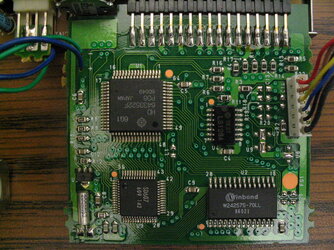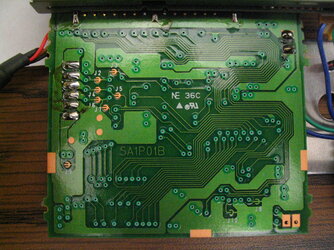BrokenLizard said:
I have used three separate methods to connect to the Communications Port. These include, an original connector borrowed from a Sega Saturn, a custom made connector (reproducing the connector inside the Sega Saturn), and soldering wires to the inside of my development system. The first two methods require a link cable, while the third allows for a microcontroller to be connected at the same time as the floppy drive. I plan on eventually creating a description of the custom connector, but I want to work on improving its design first.
I have been spending a great deal of time contemplating the final design of this project and the ability to sell individual devices. Each design possesses pros and cons. While I am still waiting to get a response from six or seven companies regarding the construction of a custom connector (the type that plugs into a Sega Saturn), the initial design costs appear to be too large for a project of this scope. A very large number of the devices would need to be sold to justify the development costs. Unfortunately, this is not practical for several reasons. The largest impediment is the software. Even if a homebrew Sega Saturn executable was created to replace the copyrighted software that was provided with the floppy drive, users would still require a method of using burnt CDs. Coupled with the fact that the Sega Saturn does not have the same following as other older video game systems, I do not believe there is a large enough demand to be able to recover the required initial investment. I would be willing to work with some who is developing a different project that also requires the custom connector, but I cannot envision a project that would sell enough units to make a difference.
There are two main designs that I am considering for this project. The first involves creating the system as originally intended, but using a connector of the same type located in the Sega Saturn. The PCB may contain pads for both an official connector (taken from a broken Sega Saturn) and the reproduction that I have developed. This design requires a link cable and will be more expensive. The second main design involves moving everything into the Sega Saturn and replacing the communications port connector with a SD Card slot (either miniSD or microSD). This design will be cheaper, does not require external power or an enclosure, may be faster, and will not require a link cable, but the communications port will no longer be available. Presently, I am leaning towards the later design because the communications port is not used by most people. Only a few games support the link cable and require two Sega Saturns. The communications port has been used to download applications to a Sega Saturn for development, but these systems are connected to a computer and the benefit from a floppy drive is reduced.
The development version of the floppy drive is mostly complete, although some additional testing is required. In the next few days, I am going to make another update to the communications protocol document. New functionality has been identified and I would like to determine the effects of some of the fields currently marked "Unknown".
Thank you for your answer, BrokenLizard !
First, let's talk about my project that requires a communications port connector.
At present time, I am using a freewing + ARP + homemade ARP firmware + homemade PC soft in order to save my old saves states.
It works well, however I got a lot of save states stored in official backup cartridges, which means I can't use my freewing to download them.
Here are some countermeasures for this:
1) Copy each saves from cartridge to Saturn's internal memory, then download each of them with my freewing.
2) Use a transmission device on a port different from ARP's.
As every software programmer should be, I hate repetitive and stupid tasks, so I don't want to use 1). And 2) seems funnier too ^^
First, I though that using Communications Port would be a nice idea, but as I am stucked in making a reliable connector, I had a new idea : why not using the second pad's port ?
It would be cheaper and easier to do so, but I don't know yet if is possible to do, and how fast (how slow ?) the transfer would be.
BTW, I am looking for a broken Saturn pad, so if somebody got one, please let me know !
(I got a bunch of Saturn pads, but I don't want to cannibalize a working one.)
Then, I got a question about your project : why focusing the data transmission only with communications port ??
IMHO, using the ARP's parallel port would be more interesting for your needs.
The image of what I am thinking about would be something looking like an USB Data Link equiped with SD card reader instead of USB port.
Here are some merit of this idea:
+ No need to spend (waste ?) time in building a custom connector.
+ As parallel connector is used to connect with Saturn, connector price would be by far cheaper than using communications port.
+ As most of customers may already own ARP, your device's selling price would be lower than using communications port based solution.
+ Solves the problem of using burnt CDs. (1)
+ If hardware is correctly designed, SD card may be used as a CDROM replacement for homebrew games. (2)
And some demerits:
- Compatibility with Saturn floppy drive is lost, hence cannot be directly used with Panzer Dragoon Azel / Saga and Dezaemon 2.
(1) A way of processing would be something like this:
- On Saturn startup, ARP's firmware is launched.
- By pressing a button on your SD card device, a Saturn executable is executed from SD to Saturn by using comms protocol.
- The Saturn executable allows to manage SD card's contents, Saturn's backup's contents, etc.
(2) In the softwares I made last year for my freewing there are functions that allow to read/write files between Saturn and PC. Hence it would be funny to do the same with your device
Thanks to this, it would allow to run homebrew stuff without worrying about burning/swapping CDs and modchipping Saturn, and without the need of using a PC !
As I told above, last year, I made an ARP custom firmware that enabled to use my buggy freewing device.
Among others, it supports data compression and error recovery during transmission, some Saturn user interface, etc.
So if you are interested in help concerning Saturn software support, please let me know
(you can contact me by mail, or simply by replying to this topic)





